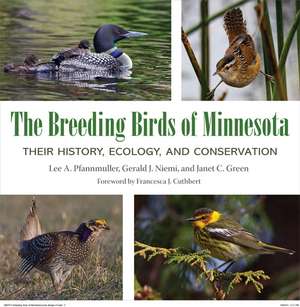The Breeding Birds of Minnesota: History, Ecology, and Conservation
Autor Lee A. Pfannmuller, Gerald J. Niemi, Janet C. Greenen Limba Engleză Hardback – 23 apr 2024
Unique among North American states, Minnesota sits squarely at the convergence of four major ecological regions, or biomes: aspen parklands, prairie grasslands, deciduous forest, and boreal forest. Consequently, the state hosts remarkably diverse avifauna. The Breeding Birds of Minnesota, the first comprehensive and in-depth assessment of Minnesota’s breeding birds in nearly a century, offers an unprecedented, extraordinarily detailed, finely illustrated account of 250 of those birds, including their historical and present breeding distribution, habitat, population abundance, and prospects for the future.
For each species, The Breeding Birds of Minnesota gives a brief life history, providing Minnesota seasonal status, migration, foods consumed, nest structure, and name origin; a summary of identification hints, primary vocalizations, and specific features of distribution or behavior; and descriptions of breeding habitat, population abundance and trend, and conservation status and threats. The heart of each account focuses on the species’ statewide distribution and abundance, beginning with a wealth of historical information from ornithological records dating from the 1800s to the early twenty-first century. An assessment of the species’ current status draws on data collected by hundreds of participants over the course of five breeding seasons, from 2009 through 2013, which was published online in 2017 in the first Minnesota Breeding Bird Atlas.
Along with permanent and complete documentation of Minnesota’s breeding birds from years past to present, this volume also identifies critical issues bird populations—and those who would protect them—will confront in coming years, including predictions of how each species will respond to climate change. Reference to T. S. Roberts’s foundational two-volume Birds of Minnesota (1936) also reveals the remarkable recovery of birds once consigned to extinction in the state (such as the American White Pelican, Sandhill Crane, and Common Raven) and the serious decline of others, like the Black Tern and Eastern Meadowlark.
In The Breeding Birds of Minnesota, three of Minnesota’s premier ornithologists present an authoritative history of the state’s avifauna, from waterfowl and waterbirds to flycatchers, thrushes, sparrows, and warblers.
Preț: 494.41 lei
Preț vechi: 642.10 lei
-23% Nou
Puncte Express: 742
Preț estimativ în valută:
94.63€ • 97.52$ • 79.89£
94.63€ • 97.52$ • 79.89£
Carte nepublicată încă
Doresc să fiu notificat când acest titlu va fi disponibil:
Se trimite...
Preluare comenzi: 021 569.72.76
Specificații
ISBN-13: 9781517906795
ISBN-10: 1517906792
Pagini: 616
Ilustrații: 1145 color plates, 14 tables
Dimensiuni: 286 x 286 x 53 mm
Greutate: 3.9 kg
Editura: University of Minnesota Press
Colecția Univ Of Minnesota Press
ISBN-10: 1517906792
Pagini: 616
Ilustrații: 1145 color plates, 14 tables
Dimensiuni: 286 x 286 x 53 mm
Greutate: 3.9 kg
Editura: University of Minnesota Press
Colecția Univ Of Minnesota Press
Notă biografică
Lee A. Pfannmuller served as state planning coordinator and interim executive director at Audubon Minnesota and director of the Division of Ecological Resources at the Minnesota Department of Natural Resources, where she also spent fifteen years working with the Nongame Wildlife Program, the Natural Heritage Program, the Scientific and Natural Areas Program, and the Division of Minerals.
Gerald J. Niemi is a retired professor of biology. From 1988 to 2008 he was director of the Center for Water and the Environment at the Natural Resources Research Institute, University of Minnesota–Duluth. His research focused on birds, the Great Lakes, conservation, and natural resource sustainability.
Janet C. Green has been observing and studying Minnesota birds since the 1960s. She has been involved with the National Audubon Society, the Duluth and Minnesota Audubon Societies, the Minnesota Ornithologists’ Union, and DNR Advisory Committees. She has authored many Minnesota bird books and guides and is cofounder of Hawk Ridge Bird Observatory.
Gerald J. Niemi is a retired professor of biology. From 1988 to 2008 he was director of the Center for Water and the Environment at the Natural Resources Research Institute, University of Minnesota–Duluth. His research focused on birds, the Great Lakes, conservation, and natural resource sustainability.
Janet C. Green has been observing and studying Minnesota birds since the 1960s. She has been involved with the National Audubon Society, the Duluth and Minnesota Audubon Societies, the Minnesota Ornithologists’ Union, and DNR Advisory Committees. She has authored many Minnesota bird books and guides and is cofounder of Hawk Ridge Bird Observatory.
Cuprins
Foreword
Francesca J. Cuthbert
Introduction
1. Minnesota’s Breeding Bird Atlas
2. Biogeography of Minnesota Birds
3. Current Breeding Species Accounts
4. Former and Incidental Nesting Species
Acknowledgments
Appendix
Notes
Bibliography
Contributors
Index
Francesca J. Cuthbert
Introduction
1. Minnesota’s Breeding Bird Atlas
2. Biogeography of Minnesota Birds
3. Current Breeding Species Accounts
4. Former and Incidental Nesting Species
Acknowledgments
Appendix
Notes
Bibliography
Contributors
Index
Recenzii
"A timely and essential reference in this age of environmental crises; its value in promoting conservation is unquestionably critical." —Francesca J. Cuthbert, from the Foreword
